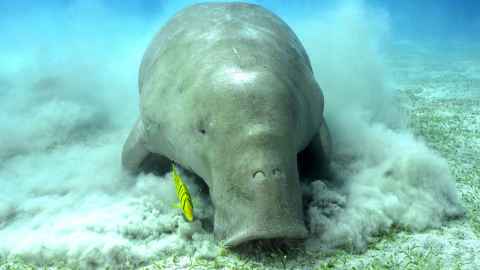New study reveals dugong in big trouble
12 September 2019
Scientists have used historic DNA to discover some of the highest-risk populations of the endangered dugong are so genetically distinct, losing them would be the equivalent of losing a species of elephant.

Dugong (Dugong dugon) are curious-looking medium-sized marine mammals distantly related to elephants and belonging to the Sirenia family of species which includes manatees. One of the largest dugong populations is found at Australia’s Great Barrier Reef but their range stretches from the east coast of Africa right across the Indian Ocean to the broader western Pacific.
Scientists have long known Indian Ocean dugong populations are most at risk from extinction, particularly the Madagascar dugong which this study shows is of a separate and unique genetic lineage and which diverged from other populations millions of years ago.
“Similar to New Zealand’s critically endangered Maui’s dolphin, the Madagascar dugong is genetically unique according to the work we have done, and this really confirms our worst fears in terms of their survival,” says Dr Shane Lavery from the University of Auckland who worked on the study.
“The study confirms there is a very low level of gene flow between geographically isolated dugong populations so that if they disappear, we won’t just lose a few more dugong, we will lose genetically distinct animals which, once lost, can never be recovered.”
Gentle and slow-moving, dugong graze seagrass on the ocean floor, earning them the common name of ‘sea cow’. Once widely hunted for their meat and skin, even after protections were introduced numbers have continued to decline due to fishing, habitat loss and ocean pollution.
“The plight of the dugong is yet another example of how destructive we humans can be to other species, and now in modern times the impacts of plastics pollution appear to be causing further population decline,” says lead author Dr Stephanie Plön from Nelson Mandela University and the African Earth Observation Network.
The death last month of an orphaned dugong caused widespread sadness in Thailand. Thousands of people had watched her recovery from a beach stranding via webcam but despite veterinary care, the calf died from an infection that vets said was exacerbated by plastic in her stomach.
“We hope that by showing the Indian Ocean dugong and in particular the Madagascar dugong are experiencing rapid biodiversity loss, we will contribute to more informed conservation decisions for this quite remarkable animal,” Dr Lavery says.
This latest research is the first to use ancient DNA from museum and university collections to carry out such a broad-based genetic study of dugong. Scientists used historic DNA, some more than 250 years old, because the scarcity of live animals means samples are increasingly difficult to collect.
The historic DNA was painstakingly extracted from bone and teeth specimens collected between 1827 and 1996 from 162 individual dugong specimens. Fragments from the extinct giant 9m-long Steller’s sea cow, closely related to the dugong, were also used in the study.
The UK’s Natural History Museum, which has one of the largest historic marine mammal collections in the world, supplied 62 of the 176 specimen samples.
Funding for the study came from the Western Indian Ocean Science Association and Ocean Park Hong Kong Conservation Fund with additional support from the Convention for Migratory Species in Abu Dhabi in the United Arab Emirates.
The study is published in PLOS One.
Media contact
Anne Beston | Media adviser
DDI 09 923 3258
Mob 021 970 089
Email a.beston@auckland.ac.nz